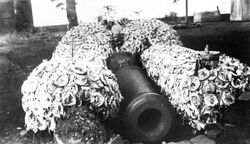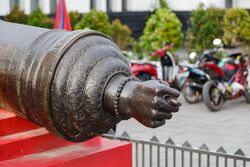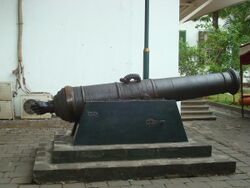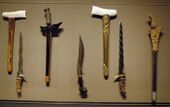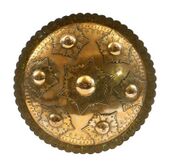Engineering:Si Jagur
Si Jagur or Ki Jagur is an old cannon of Portuguese heritage which is located in the Jakarta Fatahillah Museum.
History
Si Jagur cannon was made by a Portuguese named Manoel Tavares Baccaro in Macau, China , which was then brought by the Portuguese to Melaka, In Macau, this cannon was placed by the Portuguese in the fortress of St. Jago de Barra (St. Jago = the name of a saint, de Barra = near the beach, therefore it was called "Si Jagur").[1]
Si Jagur was transferred from Macau to Malacca at some time in the 16th century. It was brought to Batavia by the Dutch after capturing Malacca in 1641. At first the VOC cannon was placed in Batavia Fortress, to guard the port. Then it was moved to an artillery magazine near Tongkol street. After Kasteel Batavia was destroyed by Daendels in 1809 it was moved to the Oud Batavia Museum (Wayang Museum). But then it was moved again and placed in the northern part of Taman Fatahillah, between the Jakarta City post office building and Batavia Cafe. The muzzle of the cannon is directed towards the Pasar Ikan, straight towards Cengkeh street, at the back is the City Hall (Stadhuis). Initially Si Jagur was located near the Kasteel. But during the days of Governor Ali Sadikin, the cannon was moved to the northern yard of the Fatahillah Museum.[2]
It is also said that Si Jagur has a "twin", the Ki Amuk cannon belonging to the Sultanate of Banten, which is currently in the courtyard of the Banten Grand Mosque. Si Jagur has a length of 3.85 m and a caliber of 25 cm. The weight of the cannon is 3.5 tons.[1]
Legend
There are several legends about Si Jagur. First, the Raja of Pajajaran had a beautiful princess, but she contracted a strange disease. From his crotch came a miraculous light, so that the princes who wanted to marry him ran out of intention. The king then makes a contest, whoever heals his daughter will be married. Almost all shamans and smart people in Pajajaran came competing to cure the princess, but all of them failed. Until one day, a delegation of the Company (V.O.C.) came to offer itself. His Majesty agreed on condition that he exchange it with three cannons. The Company agreed and handed over the three cannons, which were named Ki Amuk, Nyai Setomi and Si Jagur.[2]
The second story, still in the Kingdom of Pajajaran or Sunda. Raja Pajajaran had a bad dream. He heard a roar from a weapon that seems very fierce and unknown to his soldiers. The King ordered his patih, Kiai Setomo, to look for this powerful weapon. A failure means death sentence. In pursuing this powerful weapon, Kiai Setomo and his wife Nyai Setomi meditated in the house. After a long time the patih was not seen, the King ordered the soldiers to search Kiai Setomo's house. But no one was found in the house, except for two large strange pipes. It turned out that Kiai Setomo and Nyai Setomi had transformed into two cannons as in the dream of the King.[2]
The story of this transformation into cannons spread everywhere, until it was heard by Sultan Agung in Mataram. Sultan Agung ordered that the two cannons be brought to Mataram, but the male cannon Kiai Setomo refused, and even "fled" to Batavia. The citizens of Batavia were in uproar watching the object and considered the object it saw as a sacred item. They then covered it with an umbrella to protect it from the sun and rain and named it Kiai Jagur or Sang Perkasa. Meanwhile Nyai Setomi was brought to Mataram.[2]
The third story, according to Voyage Autour du Monde by Ludovic Marquis de Beauvoir, is that the cannon was brought to its position (about 2 miles from Batavia's shore) by some extraordinary tide. Malay women come and settle accounts with the tutelary deity of this gun, and pray for children. The Malays surrounded it and offering incense as well as baskets full of flowers, and the heads of fighting cocks are cut off before it.[3]
See also
- Ki Amuk
- Bujang Timpang Berang
- Dardanelles gun
References
- ↑ 1.0 1.1 "Legenda Meriam “Si Jagur”" (in id-ID). 2012-03-10. http://www.berdikarionline.com/legenda-meriam-si-jagur/.
- ↑ 2.0 2.1 2.2 2.3 "Jagur, Si | Portal Resmi Pemerintah Provinsi DKI Jakarta" (in id). https://jakarta.go.id/artikel/konten/1497/jagur-si.
- ↑ Beauvoir, Ludovic (1875). Voyage autour du monde: Australie, Java, Siam, Canton, Pekin, Yeddo, San Francisco. E. Plon. https://archive.org/details/voyageautourdum04beaugoog.
External links
- Women-impregnating cannon
- Si Jagur cannon in Jakarta government website
- Jakarta History Museum information
https://belajar.kemdikbud.go.id/PetaBudaya/Repositorys/museum_sejarah_jakarta/
